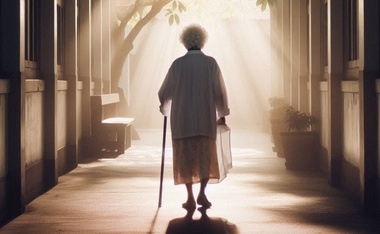As we navigate the intricate tapestry of existence, the inevitability of aging emerges as an intrinsic thread woven into the fabric of life. For the adherents of the Bahá’í Faith, the contemplation of aging transcends the mere passage of time; it instills a profound understanding of the purpose behind our earthly journey. The teachings encapsulate a philosophy that encompasses the dualities of life’s fleeting moments and the eternal spirit. In exploring these contemplations, one might liken aging to the gradual unfolding of a delicate flower, where each petal symbolizes a phase of life, revealing beauty, wisdom, and the eventual acceptance of life’s transience.
The Bahá’í perspective invites followers to view aging not merely as an end, but as a continual opening to new vistas of understanding. Embracing life in its entirety engenders an appreciation for the gifts bestowed at every age. Hence, this discussion delves into the principles of aging with grace, the act of letting go, and the essence of living fully.
1. The Nature of Aging
Aging is a phenomenon that carries with it layers of societal perceptions and personal fears. It is often painted in hues of melancholy, regarded as a time of decline or loss. However, Bahá’í teachings advocate for a recontextualization of this narrative. Aging can be understood as an evolution of the soul, an opportunity for personal development. It challenges the materialistic approach prevalent in contemporary society and ushers in the recognition of the spiritual dimensions of existence. Each stage of life is cherished, characterized not by what has been forsaken, but by the heightened consciousness of our spiritual realities.
2. Embracing Life at Every Stage
Within the Bahá’í framework, the act of embracing life encompasses more than mere acceptance; it involves the celebration of existence in all its forms. Life, akin to a kaleidoscope, presents a myriad of experiences, each one distinct yet interconnected. The Bahá’í teachings encourage individuals to engage with life actively, cultivating a sense of joy regardless of age. This perspective fosters resilience, enabling individuals to seek purpose and meaning even in the face of life’s inevitable transitions.
Engagement with community becomes a fundamental aspect of this embrace. Interaction with others serves as a catalyst for growth. The narratives and experiences shared among individuals—spanning generations—create a vibrant exchange of wisdom, enriching all those involved. This communal dimension emphasizes the interconnectedness of humanity and reinforces the belief that each generational shift carries a significance deeper than mere chronology.
3. The Art of Letting Go
Letting go, particularly in the context of aging, often emerges as a profound, yet challenging, endeavor. It demands a relinquishing of the attachments to youth and the material markers of success. Yet, paradoxically, this act of surrender is liberating. It allows for the acceptance of impermanence, fostering an appreciation of the present moment. In Bahá’í teachings, this concept resonates with the idea of detachment—an essential virtue that facilitates spiritual growth.
Just as a tree sheds its leaves in autumn, embracing the cycles of life invites a deeper understanding of renewal. The leaves fall not in sadness, but as part of a necessary metamorphosis. In this metaphor, the act of letting go symbolizes not only the acceptance of change but also the recognition of the baseline idea that life continues to flourish, even in the face of loss. One’s focus shifts from what once was to the potential of the unfolding present and the promise of what lies ahead.
4. Wisdom in Reflection
The process of aging cultivates wisdom, a prized attribute within Bahá’í teachings. Through introspection and contemplation, individuals glean insights that enrich not only their lives but also the lives of others. As one reflects on their journey, experiences transform into pearls of wisdom—each one crafted through trials and triumphs alike. This wisdom acts as a beacon, guiding younger generations and promoting a culture of learning and sharing.
Moreover, the cumulative nature of wisdom emphasizes the importance of storytelling. Each life narrative possesses intrinsic value, capable of inspiring others. Sharing one’s journey not only fosters connection among individuals but also reinforces the notion that every person’s story contributes to the broader human experience.
5. The Spiritual Perspective
At the heart of Bahá’í teachings lies a profound spiritual perspective on aging, one that encourages a harmonious relationship between body and soul. As the physical form undergoes transformation, the eternal spirit persists, seeking growth and enlightenment. The recognition that life on this plane is transient serves to deepen one’s connection to the divine, fostering an understanding of the purpose that transcends material existence.
The integration of spiritual practices into daily life becomes paramount. Prayer, meditation, and acts of service are not merely rituals; they strive to elevate the soul and nurture inner peace. These practices enhance one’s ability to navigate the complexities of each life phase and serve as anchors amidst the inevitable changes.
Conclusion
In contemplation of aging, Bahá’í teachings illuminate an intricate vista of life rich with potential for growth, understanding, and connection. Embracing life, letting go of attachments, harnessing wisdom, and cultivating a spiritual perspective collectively contribute to a holistic approach to aging. Ultimately, as one traverses the journey of life, it is the embrace of each moment—and the understanding of its significance—that ushers forth the beauty in the inevitable cycle of existence. Just as the flower unfurls under the sun, so do humans unfold in grace, revealing new layers of their essence with each passing year.
